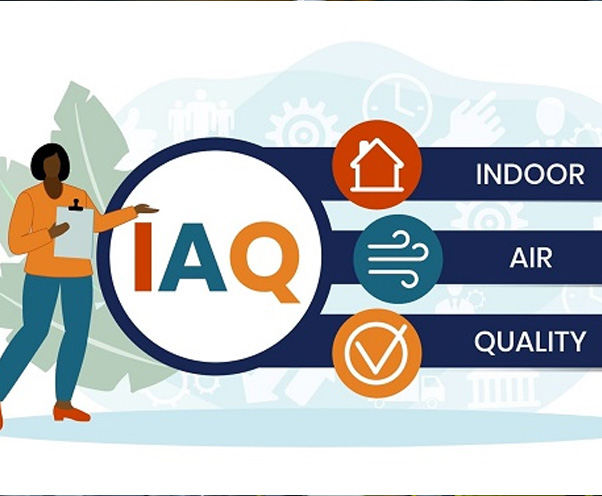Ensuring Safe Indoor Air Quality: Evaluation Methods The Role of Technology in Workplace Safety

Can Artificial Intelligence improve safety at work?
According to Voxel, an AI company based in San Francisco, it can. Voxel claims that its technology can decrease onsite injuries by over 80% and increase operational productivity by more than 20% using existing cameras. Their technology can recognize work safety hazards and alert human personnel to resolve the identified issue.
How the Internet of Things or IoT is a unique smart system that uses tiny sensors to monitor individual machines, production lines, and employees for ensuring workplace safety.
AI is an exciting advancement. It feels so futuristic to consider that computers are so advanced they can protect us humans from human error, but what if your budget does not allow for such a sophisticated monitoring system? Are you resigned to ongoing and ever-increasing workplace injuries and illnesses? Another factor is to consider how employees respond to constant artificial surveillance.
While our opinions on the topic of AI are vast and varied, the bottom line is we are moving more and more towards this technological solution. What might be financially out of reach today will be the norm tomorrow. While we wait for the technology to become more affordable and available to the masses, workplace safety is still a top priority for those whose budgets cannot accommodate artificial intelligence, at least not in its most elaborate forms.
While there are potential drawbacks to the encroachment of AI in the workplace, Occupational Wellness and workplace safety programs are necessary and desirable. At Workplace Safety Screenings, we strive to provide information that safeguards employees' health and your business's interests while respecting their privacy and bodily autonomy. We remain at the forefront of technological advancements while keeping the costs reasonable for businesses.
We understand the significance of maintaining a healthy indoor environment, particularly when it comes to air quality this time of year. In this post, we aim to provide guidance on identifying symptoms of poor indoor air quality (IAQ), understanding safety risks associated with dust and poor IAQ, evaluating your facility's combustible dust program, determining the relevant NFPA Standard for your industry, and key factors to consider when selecting protection methods. Let's delve into these crucial aspects of maintaining a safe and healthy workspace.
How to Identify Symptoms of Poor Indoor Air Quality:
Poor IAQ can lead to various health issues and discomfort for employees. Recognizing the symptoms early on is crucial. Look out for signs such as persistent coughing, eye irritation, headaches, dizziness, fatigue, and worsening of allergies or asthma symptoms among your staff. These symptoms may indicate a need to assess and improve your indoor air quality.
Safety Risks Associated with Dust and Poor IAQ:
Dust particles, often overlooked, can pose serious safety risks and compromise IAQ. Accumulation of dust can lead to respiratory problems, exacerbate existing conditions, and even cause fires or explosions in certain environments. Understanding these risks is vital for implementing effective preventive measures.
How to Evaluate Your Facility's Combustible Dust Program:
A thorough evaluation of your facility's combustible dust program is essential for mitigating potential hazards. Start by identifying areas where combustible dust may accumulate, assessing existing controls, and ensuring adherence to applicable regulations and standards. Regular inspections, employee training, and proper maintenance of dust control systems are crucial components of a comprehensive program.
Understanding Which NFPA Standard Applies to Your Industry:
The National Fire Protection Association (NFPA) sets standards and codes that address specific safety concerns in various industries. Familiarize yourself with the relevant NFPA Standard applicable to your industry to ensure compliance and implement necessary precautions. Examples include NFPA 652 for general industry combustible dust and NFPA 70E for electrical safety in the workplace.
Key Factors for Determining Your Protection Methods:
Selecting the appropriate protection methods requires a careful assessment of your facility's unique needs. Consider factors such as the nature of your operations, types of hazardous materials present, ventilation systems, and employee exposure levels. Engage with experts in the field, conduct risk assessments, and prioritize preventive measures such as engineering controls, administrative controls, and personal protective equipment (PPE).
Maintaining a safe and healthy workplace requires proactive measures to address indoor air quality concerns, dust hazards, and compliance with industry standards. By identifying symptoms of poor IAQ, recognizing safety risks associated with dust, evaluating combustible dust programs, understanding relevant NFPA Standards, and considering key factors for protection methods, you can create a safer environment for your employees. At Workplace Safety Screenings, we stand ready to assist you in evaluating your IAQ, providing advice, and supporting your commitment to workplace safety.
(This "HSE" Published in February 2024 Edition)












